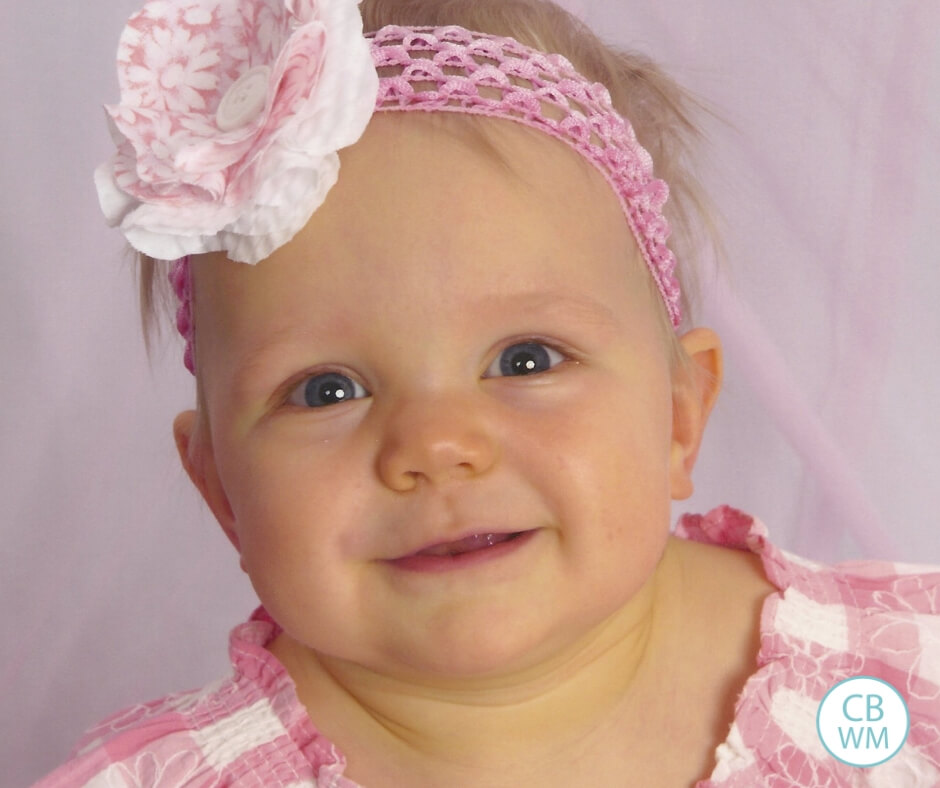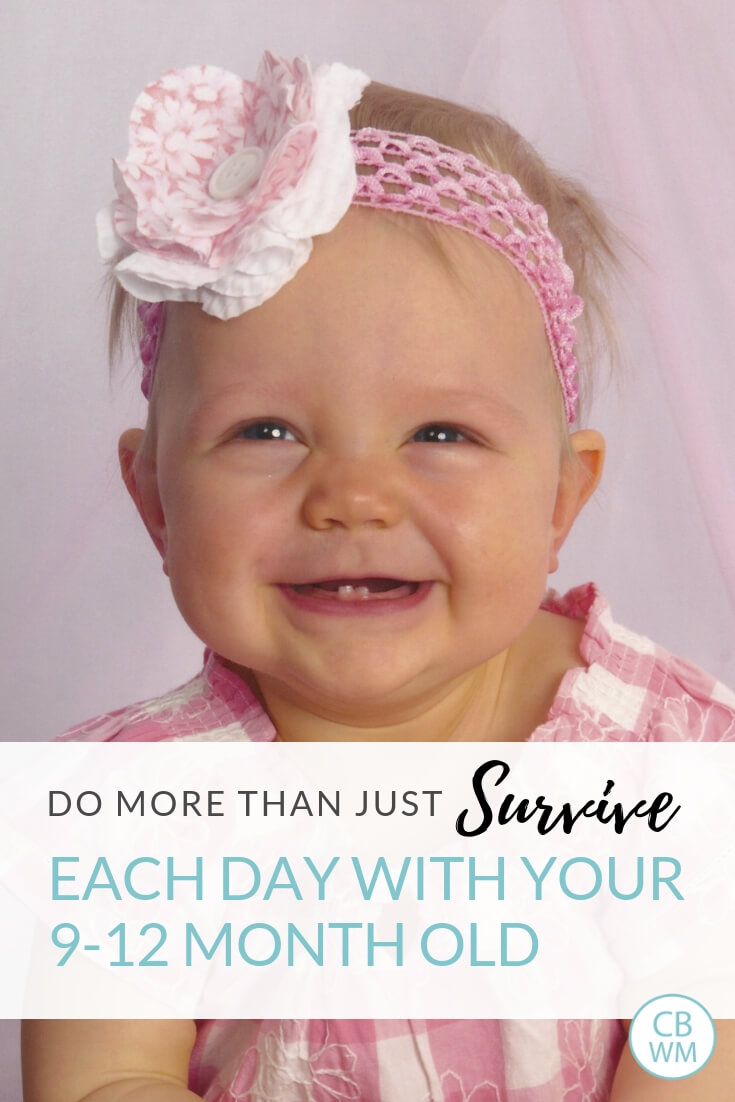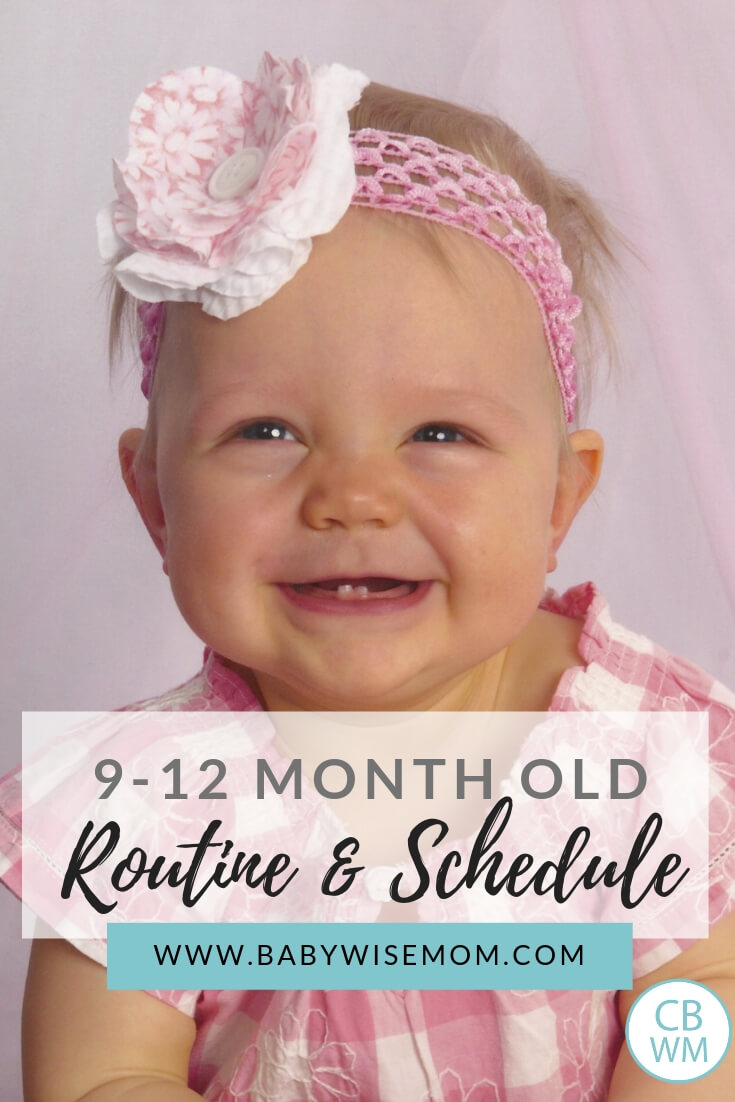More Than Making it Through the Day with your 9-12 Month Old. Sample schedule and routine for a 9-12 month old. Thrive rather than survive each day!

Many of us get quite nostalgic during the age range of 9-12 months old. Your baby is almost a year old! Your baby is almost not a baby anymore! Your baby is almost a toddler! I think most parents start to be thinking more about character training by this point.
6-9 months might have seemed really young, but 9-12 months starts to seem more appropriate. You start to really see some need for discipline (remember that discipline does not mean to punish but to correct).
Let’s go through the day for ideas on this age range. It can be a hard age range for blanket statements. Some babies start walking. Others are content to just sit in one spot, not even attempting a crawl. For this reason, there will be varying degrees for need of discipline. You have little need to correct the child who can’t move to a place she shouldn’t be.
9-12 Month Old Daily Routine
Mealtimes
By now, your baby is most likely eating solids and even finger foods. Most babies will have four liquid feedings. Some five, and some three. Here are some things to think about during this time period as far as mealtime goes:
Finger Foods: If you haven’t started finger foods yet, here is a link to my post about it: Finger Foods for Babies
Snacks: As your child is awake longer and better at communicating, she might start asking for snacks. Be careful that you maintain the healthy eating patterns you have spent the last 9 plus months making. If your child needs a snack, that is fine. Be sure it is healthy and be sure it isn’t so large that it interferes with the next meal. Snacks should be a planned part of the day. See: Snacks for Babies and Toddlers
Aligning Meals: This is the age range you might start to align meals with the family. Don’t worry if your child isn’t able to fully get there; there is plenty of time for it and it will come. See this post for more: When to Align Baby’s Meal with the Family’s
Feeding Your Pre-Toddler: Some babies (like Brayden) are quite content to continue eating baby food as the main bulk of a meal during this age range. Others, like Kaitlyn, never really enjoyed baby food in the first place and really want to move on to bigger and better things. See this post for ideas if your baby is done with baby food. If not, don’t stress. Just continue to serve the mushy stuff 🙂
Avoid Sweets: I recommend you avoid sweets and other snacky items as long as you can. This is really easy with an only child. You can save those items for when baby is not around. Older siblings tend to expose baby to those items earlier. I know it can be fun to give these treats, and I know that grandparents often really want to feed these items to baby. The longer you wait, the better. Your baby will have more opportunity to develop a love for foods that are healthy.
Avoid Salt: Your baby also doesn’t need salt and other spices on the food. Give your baby an opportunity to learn to like food as it is. You baby will have more than enough exposure to salt later in life.
Throwing Food: You baby might start (or continue) to throw food off the highchair. See: How to Stop Your Baby from Throwing/Dropping Food off of the Tray
Three Feedings: Some babies might be able to go down to three feedings around this age. I didn’t do that with mine. Both were on four until at least one year old. Brayden was quite a bit older before he went to three. See this post for more: Tips for Dropping the 4th Feeding
Weaning: You might start weaning during this period, or you might be planning on the 12 month mark (or later). This can be weaning from breast or bottle. If your baby is fed by bottle, I would suggest you start to work on weaning now. You can take it really slowly. If your child is nursed and you plan to wean at 12 months, I suggest you start thinking about how to do it so you can have a game plan in place. See How To Wean Breast, Bottle, and Formula and In Action: Weaning from Breast
Naptimes
Generally speaking, there are few nap problems during this age range. If your child does have nap problems, please don’t now freak out. Some do. But most don’t.
There can be a sleep regression around 10 months old. This does not mean it is time to drop to one nap a day. Resist the urge. Keep two naps.
Watch for sleep props: If your child has a favorite toy, blanket, finger, or pacifier to sleep with, this is the age range I noticed both of my children really get a strong attachment to these security items.
Before this age range, they liked the items while sleeping, but didn’t seem to give them a second thought once they were out of bed. During this age range, an emotional bond seemed to form.
I recommend you don’t let your child carry the item with her everywhere. Leave the pacifier in the crib. Instruct her gently to remove her fingers when they go in her mouth. It is fine to have these in bed, but try to prevent them from becoming a difficult habit to break in the future.
Third Nap: If your child hasn’t dropped the third nap yet, she will during this age range. See: Dropping Naps: A Quick Reference and Dropping the 3rd Nap (evening). Once this nap is dropped, baby’s nighttime sleep will most likely extend by 30-60 minutes–at least for a short period while she gets used to having the nap gone.
Disruptions: Most disruptions that happen during this period are due to the child learning to stand, crawl, and or walk on her own. This will cause major disruptions for a couple of days. See: New Skills and Sleep Disruptions. She might also start to play in the crib. See: Playing in the Crib/Bed
Remain Consistent: Many babies seem to need less sleep, and you might be tempted to skip naps or forget to put baby down in time for a nap. Optimal waketime is still important to the baby in this age group. Also, with all of the new activities you might be introducing, you baby might get overstimulated. If you are having nap problems, be sure there is not overstimulation or too long of a waketime.
Now on to the waketime activities.

Playtime
Here are some general thoughts for playtime:
Safety: If your baby is moving in any way, there is a good chance you have thought about Tips for Baby-Proofing Your Home. You want to keep things safe, but you also want to provide learning opportunities.
Toys: Your baby is about to leave baby-hood. Make sure you aren’t assuming she still likes those toys she loved a few months ago: Out With the Old, in With the New (toys) Here is my post for toys in this age range: Best Toys for Baby: Ages 10-12 Months
Old Classics: There are many nursery rhymes and other games you may have forgotten about. Here is a list of some of the old classics that involve movement: Peek-a-boo, Patty Cake, Itsy–bitsy Spider, This Little Piggy, Ring-a-Round the Rosies, and Pop Goes the Weasel.
Independent Playtime
If you have been doing this from the beginning, or at least prior to this point, things pretty much continue as they did. See this post on Independent Playtime.
Keep it up!: Keep up independent play. It is very much worth it. Be sure it is a scheduled part of each day.
Resistance: You might find resistance to independent play as new skills came along. This is what happened to Brayden. He was fine with independent play. He did 30 minutes at a time with no problem. Then he learned to stand on his own. For some reason, he was then very angry with independent play. I made the mistake of stopping for several months. Don’t make my mistake. Stick to it. See: Resistance to Independent Playtime
Adjust Length: Chances are you will need to adjust length now that your baby is likely gaining new physical skills: Independent Playtime Lengths
Free Playtime
Free playtime should look the same as it did in the past. Free playtime can be in the presence of other family members. She can sit in her highchair and play with toys while you make dinner. Once she can sit up on her own well, you can give her a basket of toys on the floor to play with.
If your child can now move on her own, remember that free playtime does not mean the child gets to wander the house looking for interesting things.
Sibling Playtime
If you have more than one child, you can have sibling playtime. You do not have to leave your children alone for this. What you do will depend on the age and maturity of the older child.
During this age-range, Brayden was nearing three. I felt comfortable leaving them in the room together for up to five or so minutes, but I was never more than two seconds away. The two children interacted with each other a lot more during this age range, but still basically played side-by-side rather than together. Brayden did find that he could really make Kaitlyn laugh, and both really enjoyed that.
Sibling playtime can be in a toy room, outside, and really you could have it be with something like a walk. See this post for more on sibling playtime: Sibling Playtime. I wrote it when Kaitlyn was 10 months old.
One-on-One Time With Each Parent
Be sure that you have some time set aside each day for each parent to spend quality time with the baby. This can be in conjunction with other daily activities (reading, bathing, feeding solids, etc.) or it can be simply the parent playing with the baby. This is time when you are 100% baby’s. As your baby gets older, you will most likely enjoy doing things that are more playful. You can play with toys. Dad might rough-house.
One note, if you have this one-on-one time be another activity, be sure you are focused on baby. If it is during feeding solids, don’t have the TV on, don’t be talking on the phone, etc. You are spending time with baby.
Play Dates
You can start or continue play dates. Interaction during this time will be similar to those described in the sibling playtime section above.
Language Development
Many babies will say their first word during this period if they haven’t already. You will start to see language recognition in your child, and you will most likely be astonished as you come to realize how much she understands. See this post for more: How to Enhance Your Baby’s Language Development.
Sign Language: Your child can most likely really take off with learning Sign Language. Make a goal to introduce as many words as your baby can learn. Some might be able to do one a day. Some might be able to do a few a week. Give her a chance to learn.
Read. Read books to your child. We have story time routinely with our bedtime routine. You can also have other stories during the day if you want to. Read more at The Value of Reading Aloud To Your Children
Repeat: When your baby talks to you, respond. You can repeat what she says. Maybe she says “Yummy.” You then say, “Is that food yummy? I am so glad.” When she knows you are listening to and understanding her, it will give her more motivation to speak. If she is signing, sign and say the word back to her.
Listen: When she babbles, look at her and listen to what she has to say. I will say things like, “Really?” “That is very interesting” or “I love your stories.”
Require Language Use: Once your baby has demonstrated a consistent ability to use a word, encourage her to use words. This can be either verbal or through signs. Don’t be discouraged if she mixes words up or seems to forget things she used to know. Don’t allow a tantrum to take the place of using a word she knows. See the Discipline section below for more.
Label: Label everything your baby sees. Help her to know what things are called.
Bathtime
As your baby gets older, bathtime only gets more exciting. Remember that as your child gets older, you need to be mindful of times you need to correct behavior.
Bathtime can bring opportunities. Decide on what is and isn’t okay with you. Is standing in the tub going to be okay? This is the age range that Brayden started to try to stand in the tub. Decide before this happens what is allowed and what your course of action will be when it does.
Your child will splash, and how much splashing is appropriate will depend on you. See these posts also:
Best Toys for Baby: Bath Toys
Baby Stuff I Love: Bathtime
Time Outside
Assuming the weather is good enough for your baby during this time period, spend time outside. Since your baby is now much more aware of what is going on around her, this will be a much more fascinating activity.
There is so much for your baby to take in. During this age range, Brayden was absolutely obsessed with going outside. It was a good activity for his expanding waketime. Physical activity is important, and the outdoors is a great place to encourage it.
Walks. Walks continue to be loved by baby. There are so many new things to see. Baby will likely try to communicate to you during the walk, so pay attention so you can respond to the ‘questions’ and attempts at words. Walking to destinations is fun. You can walk to the park, the duck pond, the store, etc.
Bicycle Rides: Your baby should now be strong enough to sit in a seat on your bicycle or in a bicycle trailer. This is a fun activity to add to your outside time.
Park. Your child isn’t old enough to run around the playground equipment, but she might enjoy swinging or having you help her down the slide. She also might enjoy people watching. If she can move, she will try to get to things. Keep her safe and be sure you don’t let her try things beyond her physical ability.
Bubbles: Your baby might enjoy watching you blow bubbles. She might even chase after them.
Just Outside. You can spread a blanket out, bring some toys, and let your child sit and play. There will be much for your child to observe. If your child can move, she will like to move on her own outside. She might also enjoy passing a ball back and forth to you.
Hikes. If your family enjoys this, you can go for hikes.
Other. There are so many different outdoor activities you can introduce your child to. Swimming is one. Perhaps a trip to the corn maze. Maybe sledding.
Artistic Time
Baby might be able to do some artistic activities. Keep them age appropriate. This can range from possibly coloring to singing. See Baby Stuff I love: Art Time for ideas.

Discipline
Your need for discipline will vary on the baby. Some have basically no need yet. Others have a large need. Most likely fall somewhere in between. When Brayden was this age, I remember trying to think of what was okay with me and what wasn’t.
There was a lot that didn’t bother me, but I decided to make the off-limits just so he could get the training in. With Kaitlyn, I already knew what was and wasn’t okay with me so it didn’t take much initial thought.
Remember that at this age, your child doesn’t make moral decisions. Much discipline comes just because baby has no idea if something is or isn’t okay to do. Other times, baby is simply trying to figure out life and is interested if things are always no, or if it was that one time. She also is trying to figure out what about that last time was no. She is trying to learn. See these posts for discipline ideas for this age range:
- How To Know What Freedoms to Give Baby
- Controlling the Young Temper
- Discipline: Progress is a Spiral
- Discipline Strategy: Surrender with Dignity
- The “Mini-fit”
Other Goals
Here are a few posts for further ideas for goals in this age-range:
- Change Your Strategy
- Sample Schedules
- Parenting Skills: Look to Yourself First
- Also, be sure to look to past and future More Than Making it Through the Day posts if your baby is at the beginning or end of this age range.
